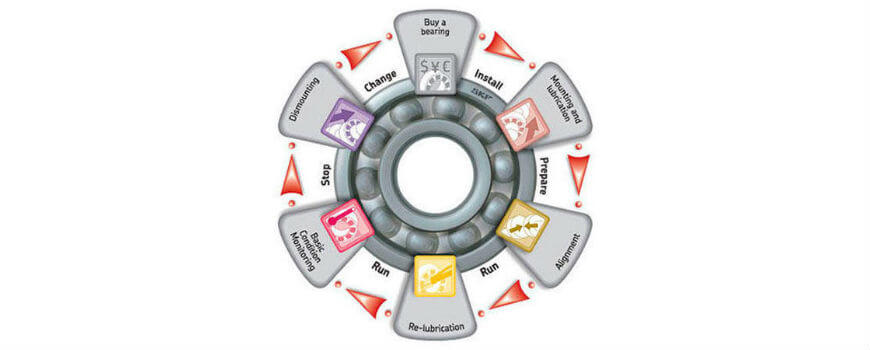
Help your bearing achieve its maximum service life !
Mounting:
Mounting is one of the critical stages of the bearing’s lifecycle. If the bearing is not mounted properly using the correct method and tools, the bearing’s service lifetime will be reduced. Individual applications may require mechanical, heat or hydraulic mounting methods for correct and efficient bearing mounting. Selecting the correct mounting technique for your application will help you extend your bearing’s service life and reduce costs resulting from premature bearing failure, as well as potential damage to the application.
Lubrication:
Correct bearing lubrication is an essential step in reaching the bearing’s service lifetime. It is important to select grease suitable for the bearing’s application, and to apply the correct quantity before commissioning the bearing. During operation, the bearing will require periodic relubrication. The right quantity of the right grease applied at the right intervals is essential to achieving optimum bearing performance and maximum service life. Using manual relubrication methods is common practice; however, continuous relubrication offers many advantages. Continuous relubrication can be performed by using automatic lubricators, which provide a more consistent, correct and contamination-free grease supply.
Alignment:
After the bearing has been mounted in an application such as a motor connected to a pump, the application should be aligned. If the application is not properly aligned, the misalignment can cause the bearing to suffer additional load, friction and vibration. These can accelerate fatigue and reduce the bearing’s, as well as other machine component’s service life. Furthermore, increased vibration and friction can significantly increase energy consumption and the risk of premature failures.
Basic Condition Monitoring:
During operation, it is important to regularly inspect the condition of the bearing by performing basic condition monitoring measurements. These regular inspections will allow the detection of potential problems and help to prevent unexpected machine stops. Consequently, the machine maintenance can be planned to suit the production schedule, increasing the plant’s productivity and efficiency.
Dismounting:
At some point, the bearing will reach the end of its service life and will have to be replaced. Although the bearing may not be used again, it is extremely important to dismount it correctly so that the service life of the replacement bearing is not compromised. Firstly, the use of proper dismounting methods tools will help prevent damage to other machine components, such as the shaft and housing, which are often re-used. Secondly, incorrect dismounting techniques can be hazardous to maintenance personnel.

